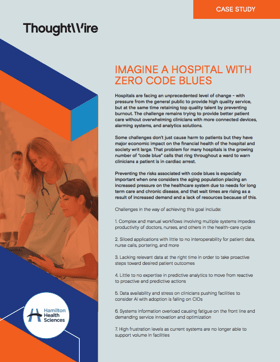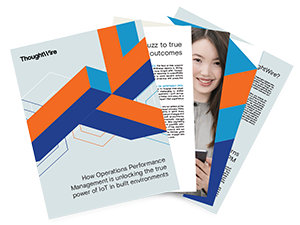The concept of Operations Performance Management (OPM) – the connecting of operational systems to improve outcomes for organizations – has been around for decades. It may be known by other names, but the goals have always been the same: increase operational efficiency, make operations run smoothly and maximize profit.
OPM is the natural progression from Asset Performance Management (APM). APM gives people the ability to monitor operational resources and predict the future health of these assets. However, APM is focused, as it isn’t designed to show how downstream asset failure impacts upstream workflows or systematic functionality. It also doesn’t show how quality goals, production targets, and other performance metrics are impacted by systematic failures.Without operations performance management, an IoT deployment is limited. OPM connects IoT collecting information from siloed data systems, as well as people who are managing systems and work across various departments and organizations. A benefit of OPM is that it is designed to support multiple work roles and complex workflows, which are common in industries with significant built environment, such as healthcare, smart cities, and real estate.
For instance, in smart hospitals, OPM can provide nurses and doctors with a unified and easily viewable way to track the status of patient vital signs. Operations performance management can also give porters and environmental staff real-time information signalling when patients are ready to be transported and when patient rooms are ready for new patients to come. Having this information available at the fingertips of providers and healthcare staff, via their mobile devices, can fundamentally transform caregiving.

Creating a Unified, People-centric Digital Transformation Plan with OPM
Most organizations pursue digital transformation initiatives and invest in new technology to improve efficiencies and cut costs. According to ARC's Michael Guilfoyle, the human element of digital transformation is often overlooked or simplistically treated as an inevitable outcome that will be dealt with on the backend. This orientation limits the ability of the organization to succeed with and scale digital transformation.
To avoid this challenge, it is incredibly important to consider exactly how newly integrated technologies will be used, deployed, tracked and orchestrated. Consider nurses in a hospital. They are the backbone of healthcare delivery organizations because they touch almost every step of the healthcare delivery value chain. Nurses touch multiple workflows and processes daily. They are inundated with data points and must make sense of them all, quickly. Adding new digital processes and new technological systems to the mix will not make their lives easier, without consideration of how nurses will operationally orchestrate the way in which newly introduced systems are integrated into pre-existing systems, processes and approaches to care.
Many organizations think of digital transformation as a “data-first” endeavor, but that bypasses the underlying value of pursuing digital transformation: to create actionable insights in real-time by equipping frontline staff with meaningful information that is easily accessible as they work. With a people-first approach, leadership teams have better insights and understanding of how they, their staff will gain value from digital initiatives. The paradigm must flip with people and change management at the forefront of digital transformation efforts.
Power of People-centric Operations Performance Management
Situating people at the center of digital transformation strategies, from ideation to execution, helps organizations better understand their actual needs and learn how those needs fit into larger business goals, from streamlining operations to reducing response time and improving experiences. Involving staff in the ideation stages of digital transformation initiatives gives them a start-to-finish understanding of how new technologies will ultimately impact the organizations they serve and the roles they play. Tapping into the tribal knowledge they possess also helps organizations improve processes and systems and, ultimately, outcomes.
Keeping staff at the center of digital transformation initiatives with OPM also improves buy-in on new technological integration, particularly by those on the front lines. For instance, one hospital has seen a 100% adoption rate of an early warning application because they deployed it on the devices the staff were already accustomed to using: mobile phones. Consequently, hospital staff are now able to deliver care more effectively and efficiently.
Impact of Operations Performance Management
Implementing a people-centric OPM strategy enables businesses and organizations to solve the immediate needs of staff and the people they serve to deliver prove solutions and measurable ROI. It also helps organizations anticipate, adapt to and predict the future needs of people using IoT in built environments.
The tendency when exploring operations performance management is to focus on forecasted results and anticipated capabilities of technological systems before considering how people will engage and interact with them. Taking a people-centric approach to IoT orchestration with OPM enables greater insights, drives greater value, improves experiences for staff and tenants and/or patients in built environments, and, in the end, sets businesses and organizations up for long-term success.
Register for our free webinar on Smart Buildings with Facility Executive here.






